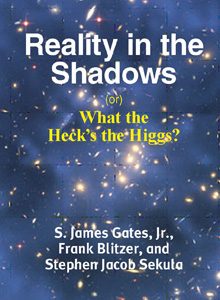
A human being is the sum of the influences of all their caregivers and bullies, successes and failures, dreams and fears… all bound together by that something special each of us has inside, that thing that ultimately makes each of us unique. I am no different. As a teenager, and later in my 20s as I pursued a Ph.D. in Physics, I was influenced by parents, teachers, friends and foes, and even the science writers to whom I was exposed by family, friends, and colleagues. With the publication of our book, “Reality in the Shadows (or) What the Heck’s the Higgs?”, Jim Gates, Frank Blitzer, and I hope now to repay the gift given to me by those science writers. I repay it not to them, but forward to a new generation (or even an existing one) by nurturing a new love of science, and especially for physics, as a principle means of inquiry into the origin, nature, and fate of the cosmos.
My father handed me his copy of Lincoln Barnett’s “The Universe and Dr. Einstein.” “Read this tonight,” he said, quite seriously, “and we’ll talk about it in the morning.” I consumed that book that night like a hungry person who had never before had access to a feast. Indeed, this book was a buffet for the mind: space and time all tangled up in one another; motion through space and time and its consequences for observed distances and durations; the resistance of a body to changes in motion and how anything with mass will never reach the ultimate speed, the speed of light. Oh… and by the way… there is a maximum speed to which anything can ever be accelerated.
I was suddenly intellectually full for the first time in my life. But I was also newly hungry to learn more. I had seen mathematics describe reality, then predict new features of reality that can be confirmed. I had seen that reality itself is far more interesting and complicated than anyone had ever before shown me. The seeds of this had been already been sown when my father shared with me, much earlier, the documentary “The Creation of the Universe,” hosted by science writer Timothy Ferris. That was the planting. “The Universe and Dr. Einstein” was the harvest. I was going to be a physicist.
Over the next 15 years, I would additionally have my understanding of the frontiers of physics influenced by books like “A Brief History of Time” (Stephen Hawking), “The Elegant Universe” (Brian Greene), and “The Demon-Haunted World: Science as a Candle in the Dark” (Carl Sagan).
The seeds of writing had been planted in me far earlier than those of science. I wanted to be a writer long before I wanted to be a scientist. It is ironic, but perhaps not surprising, that becoming a published author would take me almost twice as long as becoming a Ph.D. physicist (as Hemingway is reported to have said, “There is nothing to writing; all you do is sit down as a typewriter and bleed.”). If writing is sitting at a keyboard and bleeding, earning a Ph.D. in any science is pouring out your heart to the cosmos only to have it laugh. Getting a Ph.D. is a full-time job, and earning an academic position even more so. Such labors necessarily interrupt other plans. And why not? I love physics. Why would I have distracted myself from it?
I wrote my first “book” in elementary school, sometime around third or fourth grade, complete with illustrations. I would move to a typewriter later, and eventually a computer. The platform changed, but the writing never really stopped. I wrote crappy novels. I wrote short stories. I wrote poems. I setup blogs. I rekindled my writing activity (fiction writing, at least) when I became a faculty member, mostly as a way to fill the long hours on plane rides to and from the CERN Laboratory in Geneva, Switzerland.
So in 2016, when I was offered the chance to join an existing writing project (one initiated by Frank Blitzer, a retired aerospace engineer, who was joined later by Jim Gates, a brilliant theoretical physicist) I grew eager to aim for being a published author. I had originally been put in touch with Frank thanks to his grandson, Ryan, a film major at SMU and a Hunt Leadership Scholar (a program for which I serve as the faculty mentor). That serendipitous connection led to a fruitful writing collaboration in 2016 and 2017, culminating in the publication of our book this month.
Every chapter of this book bears the fingerprints of all of its co-authors. I work on large experimental collaborations (the BaBar Experiment, with 500 collaborators, and currently the ATLAS Experiment, with almost 3000 collaborators). Co-authoring a book with just two other people didn’t even faze me. To a regular author, working alone might seem comforting and normal, while the idea of coordinating with two co-authors in two different geographic locations might seem terrifying and alien. To a “big science” person like me, with collaborators literally spread across the globe, this project sounded rather like the coziest, friendliest, smallest writing town in America.
Frank and Jim made it additionally easy with the way they welcomed me into the project, and let me take a crack at reworking the existing material. They especially encouraged me to add new material, crucially on the Higgs Boson, Dark Matter, and the accelerated expansion of the cosmos (which is believed to be tied to an even less-well-understood phenomenon, “Dark Energy”). So while every chapter bears, to some degree, the fingerprints of every author, some chapters are more Frank, some more Jim, and some more me. The ones I feel closest to are the chapters on the Higgs (“What the Heck’s the Higgs – Part 1” and “What the Heck’s the Higgs – Part 2”) and the dark cosmos (“A Sky Full of Shadows”). But I am also proud of the way we reworked the ideas of extra dimensions and “supersymmetry” into a series of chapters that build up to the twin chapters on string theory (“The Shadows are Multiplied,” “The Walls are Multiplied”, “The Smallest Shadow Part 1: Early String Theory” and “The Smallest Shadow Part 2: Current String Theory”).
Having co-taught a course on the scientific method, and being an experimental scientist, I wear on my sleeve my bias toward evidence-based methods of assessing claims. When we discuss topics at the frontier of mathematical and physical thought, like string theory, we tried to balance the excitement over the potential of such ideas with the cold reality that there is no evidence that they are the correct description of nature. But there lies a gap, and perhaps an opportunity, and it is these unknowns – these persistent shadows begging for new light to be shed – that we ultimately gift to the reader. Perhaps some new reader will be the one who, inspired into a career in physics, finally cracks these mysteries.
I hope that this book can be used as a teaching tool in non-major courses in physics. I hope this book can be a gift to a son or daughter, niece or nephew, who shows interest in science and maybe (just maybe) needs to look beyond the veil to see how broad and fundamental physics, as a science, is to understanding everything. I hope this book can be a fresh look at physics for a lover of science writing, one that we can update periodically (thanks to print-on-demand!) with new discoveries, new puzzles, and new frontiers.
Ultimately, I hope that someday, somewhere, someone will hand this book to someone they love and say, “Read this tonight. We’ll talk about it in the morning.”

“Reality in the Shadows (or) What the Heck’s the Higgs” by S. James Gates Jr., Frank Blitzer, and Stephen Jacob Sekula. Available from Amazon.com, Barnes and Noble, and YBK Publishers. $26.95.




